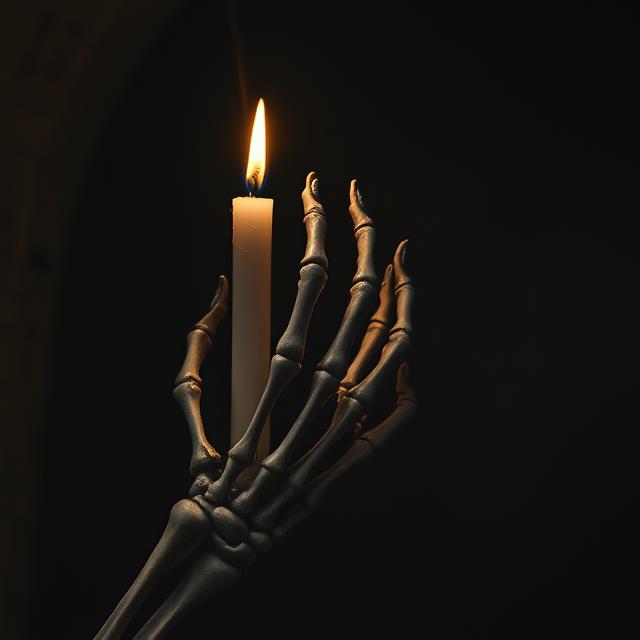Let’s uncover the eerie and unsettling folklore behind one of Old Europe’s most notorious magical relics: the Hand of Glory. This article investigates the morbid methods used to create it, the disturbing powers it was believed to possess, and its haunting role in the worlds of witchcraft, dark ritual, and the criminal underground. We’ll explore the historical roots of these beliefs and the lasting grip this grim legend has held on the imagination.
In the shadowed corners of Old Europe, where folklore entwined with fear and superstition dictated the rhythms of life, whispers circulated of a macabre magical artifact capable of paralyzing victims, unlocking doors, and revealing hidden treasures. This chilling object was known as The Hand of Glory: a severed, dried, and pickled hand, typically taken from the corpse of a hanged murderer. More than just a gruesome curio, it was believed to be a potent tool in the arsenal of witches, thieves, and practitioners of dark ritual magic, embodying a terrifying blend of death, necromancy, and illicit power. Its very existence, whether in practice or purely in chilling legend, speaks volumes about the fears and beliefs that haunted the minds of people in centuries past.
The concept of the Hand of Glory is deeply rooted in European folk magic, particularly prominent in regions like Britain, France, and parts of Germany, from the late medieval period through the 18th and 19th centuries. It is not merely a severed hand, but a specifically prepared one, imbued with mystical properties through a grisly ritual.
The process of creating a Hand of Glory, as described in various grimoires and folklore accounts, is as horrifying as its intended use:
- The Source: The hand had to be specifically severed from the corpse of a hanged criminal, ideally one who had committed a heinous act, such as murder. The belief was that the hand of someone who had suffered a violent death, particularly by hanging, retained a powerful, malignant energy.
- Preparation (Drying and Pickling): Once severed, the hand would undergo a gruesome preservation process. It would be pressed to expel any remaining blood, then dried, often by salting and smoking, or in some accounts, by pickling it in various gruesome concoctions. It might be left in a hot oven or even exposed to sunlight for a prolonged period. This process would mummify the hand, preventing decomposition.
- Candle Preparation: The most vital element of the Hand of Glory was the special candle that accompanied it. This candle was not ordinary wax. It was often rendered from the fat of the hanged murderer himself, or from the fat of other executed criminals. Sometimes, it was believed to require the fat of infants or other macabre ingredients. The wicks for these candles were frequently made from the murderer’s hair.
- Insertion: Once prepared, this specially crafted candle would be placed between the fingers of the mummified hand, typically held upright. In some versions, the candle might be held by the thumb and forefinger, or even inserted into a hole bored into the hand itself.
The ritualistic nature of its creation, using elements directly from a corpse, solidified its connection to necromancy and the darker arts. It was a clear violation of Christian burial practices and a potent symbol of defiance against divine and societal norms.
The alleged powers of the Hand of Glory were terrifying and highly specific, making it a prized, albeit dangerous, tool for criminals and those dabbling in black magic:
- Paralysis and Immobility: The most frequently cited power was its ability to render all inhabitants of a house completely immobile and speechless upon its activation. As the candle in the hand glowed, anyone inside a dwelling would be frozen in place, unable to move, scream, or resist. This was invaluable for thieves. The only ones immune were those whose souls were pure, or who had been specially protected by other charms.
- Unlocking Doors: It was also believed that the Hand of Glory could miraculously unlock any door, no matter how securely fastened, allowing its user unhindered access. This made it the ultimate locksmith for burglars and intruders.
- Illuminating Hidden Treasures: Some legends claimed the Hand could illuminate hidden treasures or secret passages, casting its eerie light only on valuables or concealed routes. This made it useful for searching for loot or secret hiding places.
- Invisibility or Protection for the User: While not universally agreed upon, some versions suggested the Hand offered a degree of invisibility or protection to the person wielding it, allowing them to move through the paralyzed household undetected.
The Hand of Glory was typically employed by thieves. A burglar, armed with this grotesque implement, could enter a house, light the candle in its mummified grasp, and then proceed to loot at leisure while the occupants remained frozen, helpless witnesses to the theft. The dread of such an object was profound; it represented an attack not just on one’s property, but on one’s very will and body.
The historical context of these beliefs is crucial. In Old Europe, particularly before the Enlightenment, the lines between medicine, magic, and religion were often blurred. Superstition was rampant, and a belief in curses, charms, and the supernatural influence of the dead was commonplace. The fear of witchcraft was real, leading to witch hunts and trials. Within this worldview, an object like the Hand of Glory, combining the power of the dead with ritualistic preparation, would have seemed entirely plausible.
Law enforcement and local authorities of the time were well aware of the legend. In some regions, finding a Hand of Glory was considered a serious crime, punishable severely. Folklore also contained countermeasures against its power, such as anointing the threshold of a house with a special ointment or using the blood of certain animals.
Despite the pervasive legend and its detailed descriptions, concrete archaeological or official historical evidence for the widespread use or even existence of perfectly preserved “Hands of Glory” is remarkably scarce. While individual severed hands and necromantic practices certainly existed, the elaborate preparation and consistent magical application of the Hand of Glory as described in folklore might have been more prevalent in grimoires and whispered tales than in actual criminal practice.
It is possible that:
- It was rarely used: Its extreme nature meant it was only attempted by the most desperate or deranged.
- Evidence was destroyed: Its illegal and occult nature would lead to careful concealment or destruction if discovered.
- The legend outgrew the reality: The chilling concept itself was so powerful that it became a potent deterrent or an explanation for unexplained crimes, perpetuating the myth far beyond any actual usage.
- Misinterpretations: Perhaps rudimentary forms of “sleep gas” or other incapacitating agents were used, and the Hand of Glory provided a supernatural explanation for the victims’ paralysis.
Regardless of its factual prevalence, the Hand of Glory has cemented its place in macabre folklore, inspiring numerous horror stories, poems, and references in popular culture. Its image evokes a primal fear: the undead grasping for power, the desecration of the human form, and the sinister blend of occult knowledge with criminal intent. The dark shadows of Old Europe continue to whisper tales of the Hand of Glory, a grim reminder of a time when the boundaries of magic, crime, and terror were chillingly intertwined.
Want to explore the shadows even deeper? For more chilling cases like this, visit SinisterArchive.com, where the legends are real.




